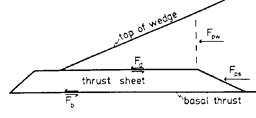 |
Science Frontiers ONLINE No. 74: Mar-Apr 1991 |
|
|
The Mechanical Paradox In Thrust Faulting
In many parts of the world, older rocks are found on top of younger rocks. Ob-viously the Principle of Superposition is contradicted in such situations. Two possible explanations exist for these inverted strata: (1) The dating of the rocks is incorrect; or (2) Geological forces somehow slid the older rocks over the top of the younger rocks. Few mainstream scientists give any thought to the first possibility because it implies that evolution did not proceed as presently envisioned. (Rocks are often dated by their fossil contents.) So, geologists are left with the problems of sliding great masses of rock over rough surfaces for great distances.
 Sketch of the forces acting upon a thrust block being pushed by a wedge-shaped driver |
Three potential solutions have been proposed: (1) Lubricate the sliding surfaces with water under high pressure (the pore-pressure approach); (2) Allow the thrust block to slide, not as a unit, but in small discrete areas at different times (the dislocation approach); and (3) Push the thrust block not only from the rear edge but along the top surface (the tapered wedge approach). In fact, all three solutions may apply; but there is no consensus so far. Each solution has problems. (Washington, Paul A., and Price, Raymond A.; "The Mechanical Paradox of Large Overthrusts; Alternative Interpretation and Reply," Geological Society of America, Bulletin, 102:529, 1990.)
Comment. Note that scientific creationists consider large thrust faults as arrows in their quiver. If a "geological solution" cannot be found, the order of life's evolution might be at risk, for how else can we explain old rocks superimposed upon younger rocks, especially in those cases where there is little if any evidence of gross sliding? Happily, a "geological solution" does not seem out of reach.
Reference. Thrust faulting and strata that are apparently out of sequence are discussed in depth in ESR3 in the book Inner Earth. Information on this book here.